11 Optical Activity
Chapter 11 Learning Objectives
- Be able to define optical activity.
- Be able to describe the function of a polarimeter in distinguishing chiral and achiral compounds.
- Define observed rotation and specific rotation.
- Be able to apply the principle of optical activity to distinguish between various types of chiral and achiral compounds.
11.1 Optical Activity
When a beam of ordinary light is passed through a polarizing lens, light waves that oscillate in only a single plane are obtained. This light is said to be plane polarized. Rotation of plane polarized light by a chiral compound is known as optical activity. Achiral compounds are optically inactive. Racemic mixtures are optically inactive because the molecule and its mirror image rotate light in equal magnitude but opposite direction. Even though meso compounds have stereogenic carbon atoms, the plane of symmetry in the molecule renders the molecule optically inactive. Racemic mixtures are optically inactive due to external cancellation while meso compounds are inactive due to internal cancellation of optical activity. The phenomenon of optical activity was discovered by Jean-Baptiste Biot in 1815.
11.2 Polarimeter
The instrument used to measure optical activity is called a polarimeter. A polarimeter is an instrument that allows polarized light to travel through a sample tube containing an organic compound and the degree to which an organic compound rotates plane-polarized light is measured.
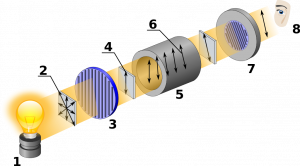
Figure 11.1: Schematic of a Polarimeter
1: Light source; 2: Unpolarized light; 3: Polarizing lens: 4: Plane polarized light: 5: Sample tube: 6: Rotated light; 7: Analyzer; 8: viewer
Source: https://commons.wikimedia.org/wiki/File:Polarimeter_(Optical_rotation).svg
The light used to measure optical activity has two properties
- it is monochromatic (Sodium D line)
- it is plane polarized
The sample is optically active if it rotates the plane of polarized light. The degree of rotation is called observed rotation, α. Substances that rotate plane polarized light to the right are called dextrorotatory and is indicated by (+), and rotation to the left is levorotatory (-). Enantiomers rotate the light to the same magnitude but opposite direction.
The spatial orientation of the groups at a chiral center is its absolute configuration (denoted by R and S). The magnitude and the sign of the optical rotation can tell us nothing about its absolute configuration. Cahn-Ingold-Prelog rules are used to determine R/S configuration.
The two enantiomers are mirror images of each other. They are very alike and share many properties in common, like same b.p., m.p., density, color, solubility etc. In fact, the pair of enantiomers have the same physical properties except the way they interact with plane-polarized light. For a pair of enantiomers with same concentration, under the same condition, they rotate the plane of polarization with the same angles but in opposite direction, one is clockwise and the other is counterclockwise. The enantiomer rotates the plane of polarization clockwise is said to be dextrorotatory (Latin, means to the right), and labelled with the prefix (d) or (+). The enantiomer rotates the plane of polarization counterclockwise is said to be levorotatory (Latin, means to the left), and labelled with the prefix (l) or (–). The d/l (or +/-) indicate the direction in which an optical active compound rotates the plane of polarization of plan-polarized light, that has to be determined by experiment to measure the optical rotation. d/l (or +/–) symbol has nothing to do with R/S. R/S indicates the arrangement of the groups around the chirality center, that can be determined by knowing the exact spatial arrangement of the groups. That means compound with R configuration can be either d or l, and compound with S configuration can also be either d or l. For the examples below, both compounds are S-isomer, but one is d (+) and the other is l (-).

The only thing we can be sure is that for a pair of enantiomers, if one enantiomer has been determined as d, then the other enantiomer must be l, and vice versa.
11.3 Observed and Specific Rotation
Since the measurement results vary with the wavelength of the light being used, the specific light from a sodium atomic spectrum with the wavelength of 589 nm, which is called the sodium D-line, is used for most polarimeters. The rotation degree measured by the polarimeter is called the observed rotation (α), and the observed rotation depends on the length of the sample tube, concentration of the sample and temperature.
To compare the optical rotation between different compounds under consistent conditions, the specific rotation ![]() is used. Specific rotation is the rotation caused by a solution with concentration of 1.0 g/mL in a sample tube of 1.0 dm length. The temperature is usually at 20°C. Based on this definition, the specific rotation can be calculated from the observed rotation by applying the formula:
is used. Specific rotation is the rotation caused by a solution with concentration of 1.0 g/mL in a sample tube of 1.0 dm length. The temperature is usually at 20°C. Based on this definition, the specific rotation can be calculated from the observed rotation by applying the formula:

Examples: Calculate the specific rotation.
The observed rotation of 10.0g of (R)-2-methyl-1-butnaol in 50mL of solution in a 20-cm polarimeter tube is +2.3° at 20 °C, what is the specific rotation of the compound?
Solution:


11.4 Optical Activity of Different Samples
When a sample under measurement only contain one enantiomer, this sample is called as enantiomerically pure, means only one enantiomer is present in the sample.
The sample may also consists of a mixture of a pair of enantiomers. For such mixture sample, the observed rotation value of the mixture, together with the information of the specific rotation of one of the enantiomer allow us to calculate the percentage (%) of each enantiomer in the mixture. To do such calculation, the concept of enantiomer excess (ee) will be needed. The enantiomeric excess (ee) tells how much an excess of one enantiomer is in the mixture, and it can be calculated as:

We will use a series of hypothetic examples in next table for detailed explanation.
|
If the specific rotation of a (+)-enantiomer is +100°, then the observed rotation of the following samples are (assume the sample tube has the length of 1 dm, and the concentration for each sample is 1.0 g/mL):
|
||
| Sample Number |
Sample |
Observed rotation (º) |
| 1 | pure (+) enantiomer | +100 |
| 2 |
Pure (-)-enantiomer
|
-100 |
| 3 | Racemic mixture of 50% (+)-enantiomer
and 50% (-)-enantiomer |
0 |
| 4 | Mixture of 75% (+)-enantiomer and 25% (-)-enantiomer |
+50 |
| 4 |
Mixture of 20% (+)-enantiomer and 80% (-)-enantiomer
|
-60 |
Sample #1 and #2 are straightforward.
Sample #3 is for a mixture with equal amount of two enantiomers, and such mixture is called racemic mixture or racemate. Racemic mixtures do not rotate the plane of polarization of plane-polarized light, that means racemic mixtures are optical inactive and have the observed rotation of zero! This is because that for every molecule in the mixture that rotate the plane of polarization in one direction, there is an enantiomer molecule that rotate the plan of polarization in the opposite direction with the same angle, and the rotation get cancelled out. As a net result, no rotation is observed for the overall racemic mixture. The symbol (±) sometimes is used to indicate a mixture is racemic mixture.
Sample #4, the (+)-enantiomer is in excess. Since there are 75% (+)-enantiomer and 25%(-)-enantiomer, the enantiomeric excess (ee) value of (+)-enantiomer is 75% – 25% = 50%, this can also be calculated by the formula: ee = ![]()
In this sample of mixture, the rotation of the (-)-enantiomer is cancelled by the rotation caused by part of the (+)-enantiomer, so the overall net observed rotation depends on how much “net amount” of (+)-enantiomer present. This can be shown by the diagram below that helps to understand.
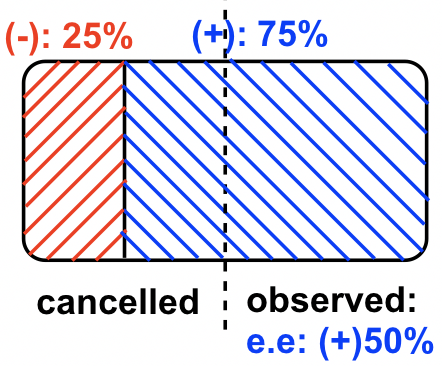
Sample #5, the (-)-enantiomer is in excess, and because there is 80% (-)-enantiomer and 20% (+)-enantiomer, the enantiomeric excess (ee) value of (-)-enantiomer is 80% – 20% = 60%, this can also be calculated by the formula: ee = ![]()
Exercises 11.1
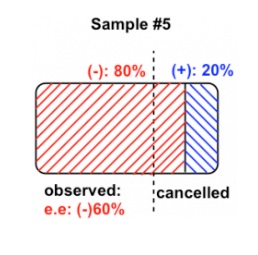
Examples: An advanced level of calculation.
The (+)-enantiomer of a compound has specific rotation ([α]20D) of +100°. For a sample (1 g/ml in 1dm cell) that is a mixture of (+) and (-) enantiomers, the observed rotation α is -45°, what is the percentage of (+) enantiomer present in this sample?
Solution:
The observed rotation is in “-”, so (-)-enantiomer is in excess.
ee of (-)-enantiomer is: ![]()
From here, we will see two ways of solving such type of question:
Method I: solving algebra
% of (-)-enantiomer is set as “x”; % of (+)-enantiomer is set as “y”
x + y = 100%
x – y = 45%
Solve x = 72.5%; y = 27.5%;
So there is 72.5% (-)-enantiomer and 27.5% of (+)-enantiomer in the sample.
Method II: using diagram, the answer is in blue color, there is 27.5% of (+)-enantiomer.
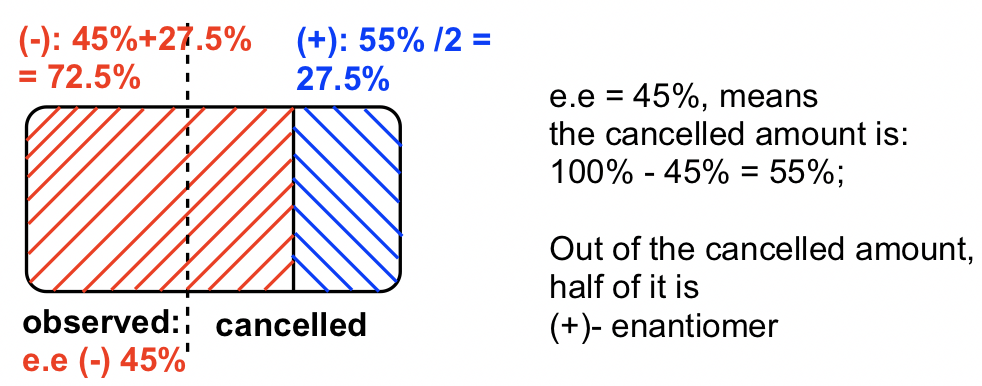
11.5 Chirality and Biological Properties
Other than optical activity difference, the different enantiomers of a chiral molecule usually show different properties when interacting with other chiral substances. This can be understood by using the analogue example of fitting a hand into the respective glove: right hand only fits into right glove, and it feels weird and uncomfortable if you wear left glove on the right hand. This is because both right hand and right glove are chiral. A chiral object only fit into a specific chiral environment.
In human body, the biological functions are modulated by a lot of enzymes and receptors. Enzymes and receptors are essentially proteins, and proteins are made up of amino acids. Amino acids are examples of naturally exist chiral substances. With the general formula given below, the carbon with amino (NH2) group is the chirality (asymmetric) center for most amino acids, and only one enantiomer (usually S-enantiomer) exist in nature. A few examples of amino acids are given below with the general formula.

Because amino acids are chiral, proteins are chiral so enzymes and receptors are chiral as well. The enzyme or receptor therefore form the chiral environment in human body that distinguish between R or S enantiomer. Such selectivity can be illustrated by the simple diagram below.
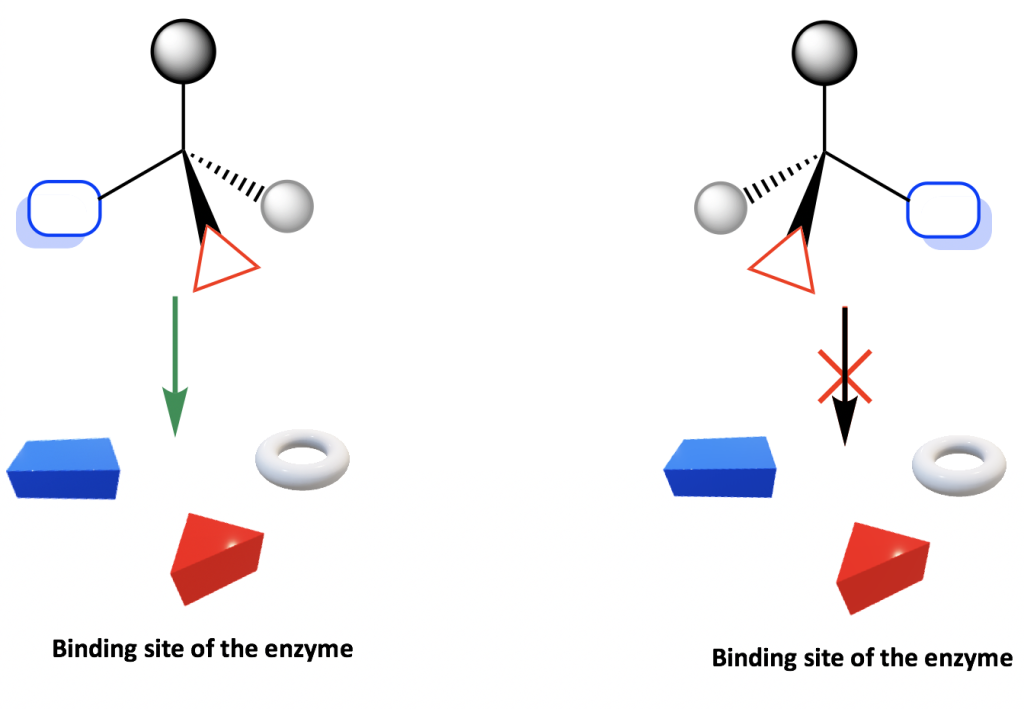
The binding site of enzyme or receptor is chiral, so it only binds with the enantiomer whose groups are in the proper positions to fit into the binding site. As shown in the diagram, only one enantiomer binds with the site, but not the other enantiomer.
A couple of common examples to showcase such binding selectivity of different enantiomer may include limonene and carvone.
Limonene has two enantiomers, and they smell totally different to human being because they interact with different receptors that located on the nerve cells in nose. The (R)-(+)-limonene is responsible for the smell of orange, and the (S)-(-)-limonene gives the bit smell of lemon.
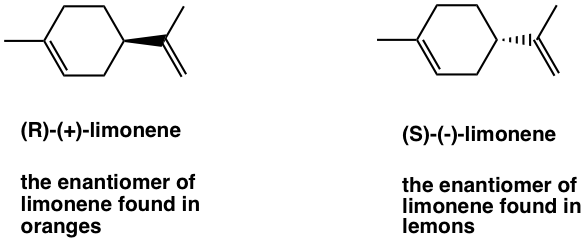
If you like caraway bread, that is due to the (S)-(+)-carvone; and the (R)-(-)-carvone that is found in spearmint oil gives much different odor.

11.6 Chiral Drugs
Most of the drugs derived from nature are chiral. Many of the drugs sold are racemic mixtures, even though the desired therapeutic activity is only from one of the enantiomers. There is a high degree of chiral recognition in biological processes; it is unlikely that both enantiomers of a chiral drug will exhibit the same effect. Most of the time, 50% of the drug exhibits desired activity, and 50% of the drug is inert or exhibits harmful activity. For example, the S enantiomer is responsible for the pain relieving properties of ibuprofen, normally sold as the racemic mixture. The R isomer is not completely wasted. Enzymatic reactions in the body convert much of it to the S isomer. A more serious case is the drug, thalidomide (antinausea drug for pregnant women). R enantiomer has the desired properties. However, the S isomer was responsible for serious birth defects. The challenge is to devise synthetic routes that result in pure enantiomeric form.

The issue of chiral drugs (the drug contain a single enantiomer, not as a racemate) was not in the attention of drug discovery industry until 1960. Back then, drugs were approved in racemate form if a chirality center involved, and there was no further study about biological difference on different enantiomers. These were all changed by the tragic incident of thalidomide. Thalidomide was a drug that was sold in more than 40 countries, mainly in Europe, in early 1960s as a sleeping aid and to pregnant women as antiemetic (drug that preventing vomiting) to combat morning sickness. It was not recognized at that time that only the R-enantiomer has the property, while the S-enantiomer was a teratogen that causes congenital deformations. The drug was marketed as a racemic mixture and caused about 10,000 children had been damaged until it was withdrawn from the market in Nov. 1961. This drug was not approved in US however, attributed to Dr. Frances O. Kelsey, who was a physician for the FDA (Food and Drug Administration) at that time and had insisted on addition tests on some side effects. Thousands of life were saved by Dr. Kelsey, and she was awarded the President’s medal in 1962 for preventing the sale of thalidomide.
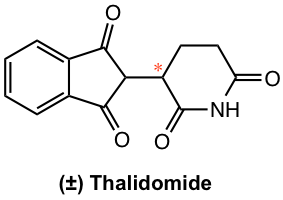
In contrast to drugs from natural sources, drugs that are made entirely in the laboratory are either achiral or, if chiral, are often produced and sold as racemates. Ibuprofen, for example, has one chirality center and is sold commercially under such trade names as Advil, Nuprin, and Motrin as a 50 : 50 mixture of R and S. It turns out, however, that only the S enantiomer is active as an analgesic and anti-inflammatory agent. The R enantiomer of ibuprofen is inactive, although it is slowly converted in the body to the active S form.
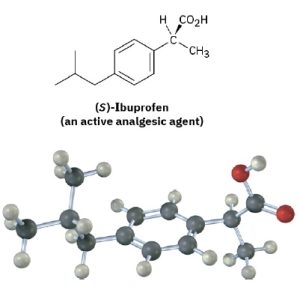
Not only is it chemically wasteful to synthesize and administer an enantiomer that does not serve the intended purpose, many instances are now known where the presence of the “wrong” enantiomer in a racemic mixture either affects the body’s ability to utilize the “right” enantiomer or has unintended pharmacological effects of its own. The presence of (R)-ibuprofen in the racemic mixture, for instance, slows the rate at which the S enantiomer takes effect in the body, from 12 minutes to 38 minutes. To get around this problem, pharmaceutical companies attempt to devise methods of enantioselective synthesis, which allow them to prepare only a single enantiomer rather than a racemic mixture.

